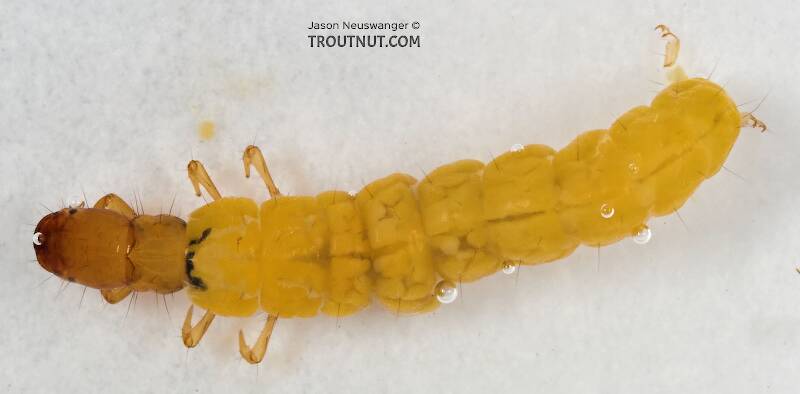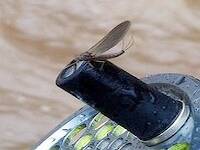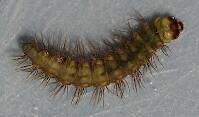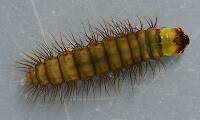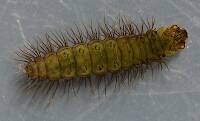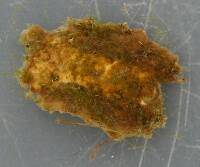
Hex Mayflies
Hexagenia limbata
The famous nocturnal Hex hatch of the Midwest (and a few other lucky locations) stirs to the surface mythically large brown trout that only touch streamers for the rest of the year.
Featured on the forum

This seems to be a young larva of Limnephilus. Although not clear in the picture, several ventral abdominal segments have chloride epithelia.

Troutnut is a project started in 2003 by salmonid ecologist Jason "Troutnut" Neuswanger to help anglers and
fly tyers unabashedly embrace the entomological side of the sport. Learn more about Troutnut or
support the project for an enhanced experience here.
Mlajoie
Posts: 6
Posts: 6
Mlajoie on Mar 19, 2008March 19th, 2008, 6:37 am EDT
This is not a Philopotamid. It is Psychomyiidae and it looks like Lype sp. but it is hard to see the sclerites on the mentum. It would be easy to ID with a close-up of the anal claws and ventral side of the head. Lype does not have long ventral teeth on the claws like Psychomyia sp., ventral teeth on the anal claws, that is.
Mlajoie
Posts: 6
Posts: 6
Mlajoie on Mar 31, 2008March 31st, 2008, 4:11 am EDT
You know how sometimes you just want to unsend an email... I could be wrong on this ID. In fact, after reinspection, I'm leaning more toward Philopotamidae. Without being able to see a hatchet-shaped foretrochantin (Psychomyidae) you can't definitively ID even to family. The way the fleshy mesonotum overlaps the dark posterior margin of the pronotum, along with the apparent lack of T-shaped labrum, led me to suspect a Psychomyid (but occasionally you can see this with Philopotamids, too). The head shape also appears to be more consistent with Psychomyidae, but now I suspect that it may be the angle of the shot. You definitely can't see the venter of the anal claws clearly or a clear view of the mental schlerites, so I don't think we can be confident about labeling the genus of this photo set. Heck, the family may even be wrong. My statement that it looks like Lype wasn't based on specific diagnostic characteristics, and I didn't mean for it to be taken as a definite ID. Sorry for any confusion.
Given a real specimine, the ID would be immediately obvious, but based on these photos, I'm not at all confident of the correct ID.
Again, sorry for the confusion.
-Matt
Given a real specimine, the ID would be immediately obvious, but based on these photos, I'm not at all confident of the correct ID.
Again, sorry for the confusion.
-Matt
Creno on May 3, 2008May 3rd, 2008, 12:02 pm EDT
Folks - just got back to looking through the taxonomy discussions and I don't think this is a psychomyiid. The forelegs are too long. In general all the legs are too long for psychomyiids - in particular the femur is long and appears nearly circular in cross section. They are usually much shorter and laterally compressed in the psychomyiids.
But just because we know what it is not doesn't mean we know what it is. Very few of the larval polycentropid species have been associated so any guesses based on these photos are just that. I guess Nyctiophylax. That is based almost solely on what we can see of the anal leg and claw. The claw appears to be a more smoothly curved arc than any of the polycentropids I have seen.
I want to thank Jason for putting up these great photos. They are a real test for all of us and our knowledge of the critters, not just a key. And on a selfish note, they are great practice for the "stump the chump" stuff I get involved in. For the readers who are going to the North American Benthological Society meeting the end of the month bring your unknown critters and stop by the Taxonomy Fair - you can find alot of chumps there who enjoy a good challenge - or just talking critters.
dave
But just because we know what it is not doesn't mean we know what it is. Very few of the larval polycentropid species have been associated so any guesses based on these photos are just that. I guess Nyctiophylax. That is based almost solely on what we can see of the anal leg and claw. The claw appears to be a more smoothly curved arc than any of the polycentropids I have seen.
I want to thank Jason for putting up these great photos. They are a real test for all of us and our knowledge of the critters, not just a key. And on a selfish note, they are great practice for the "stump the chump" stuff I get involved in. For the readers who are going to the North American Benthological Society meeting the end of the month bring your unknown critters and stop by the Taxonomy Fair - you can find alot of chumps there who enjoy a good challenge - or just talking critters.
dave
Troutnut on May 3, 2008May 3rd, 2008, 4:33 pm EDT
OK, then, I'm moving this one all the way up to "Trichoptera" and not giving it a family ID.
Have fun at NABS. I'm not going this year, but my advisor and a couple of my labmates are.
Have fun at NABS. I'm not going this year, but my advisor and a couple of my labmates are.
Jason Neuswanger, Ph.D.
Troutnut and salmonid ecologist
Troutnut and salmonid ecologist
Creno on May 4, 2008May 4th, 2008, 11:27 am EDT
You mean you are not willing to go at least to family based on a hunch?
dave
dave
Troutnut on May 4, 2008May 4th, 2008, 7:38 pm EDT
Half the IDs on this site are based on hunches. I just got confused after reading through this thread as to which hunch pointed where. I'll call it a Polycentropid for now if you want.
Jason Neuswanger, Ph.D.
Troutnut and salmonid ecologist
Troutnut and salmonid ecologist
Taxon on May 4, 2008May 4th, 2008, 9:01 pm EDT
Hey guys-
What is a Polycentropid? Do you mean Polycentropodid? Isn't that what a member of family Polycentropodidae is called?
What is a Polycentropid? Do you mean Polycentropodid? Isn't that what a member of family Polycentropodidae is called?
Creno on May 7, 2008May 7th, 2008, 12:52 pm EDT
Roger - thanks for catching the typo. We haven't heard back from Matt to see if we are approaching any degree of consensus on our hunches.
dave
dave
Entoman on Mar 20, 2012March 20th, 2012, 1:06 pm EDT
Jason & Dave,
Jason - Can you remember the water type you collected this specimen from? It seems this would have a lot of bearing on sorting this out and it wasn't discussed for some reason. I believe tumbling little brooks and cobble headwaters are the preferred habitat of Philopotamidae (Finger-net Caddis) whose nets are better adapted to moving water. The polycentropodids (Trumpet-net Caddis) are better adapted to stillwaters. They are mostly pond fauna out here. Their nets are so dense they look like cases and are not well adapted to moving water. I wouldn't think you'd find them with hydropsychids.
Dave - Between questions about habitat and from what I can see in the photo, I'm taxonomically vexed. The specimen looked more like a philopotamid to me at first glance as I thought polycentropodids usually had spotted head capsules (at least the ones I've seen in the West) and their pronotums usually tapered from front to back. I was puzzled by your dismissal of philo without a mention when suggesting poly, especially after explaining why it wasn’t a psychomyiid. At first I thought perhaps you made a typo. Then I enlarged the photo and noticed I couldn't find the flat-edged scraper, and I think I might be seeing a pointy trochantin. Hmmm... I don't think this is a psychomyiid and it should be moved to Polycentropodidae. Am I on the right track here?
Jason - Can you remember the water type you collected this specimen from? It seems this would have a lot of bearing on sorting this out and it wasn't discussed for some reason. I believe tumbling little brooks and cobble headwaters are the preferred habitat of Philopotamidae (Finger-net Caddis) whose nets are better adapted to moving water. The polycentropodids (Trumpet-net Caddis) are better adapted to stillwaters. They are mostly pond fauna out here. Their nets are so dense they look like cases and are not well adapted to moving water. I wouldn't think you'd find them with hydropsychids.
Dave - Between questions about habitat and from what I can see in the photo, I'm taxonomically vexed. The specimen looked more like a philopotamid to me at first glance as I thought polycentropodids usually had spotted head capsules (at least the ones I've seen in the West) and their pronotums usually tapered from front to back. I was puzzled by your dismissal of philo without a mention when suggesting poly, especially after explaining why it wasn’t a psychomyiid. At first I thought perhaps you made a typo. Then I enlarged the photo and noticed I couldn't find the flat-edged scraper, and I think I might be seeing a pointy trochantin. Hmmm... I don't think this is a psychomyiid and it should be moved to Polycentropodidae. Am I on the right track here?
"It's not that I find fishing so important, it's just that I find all other endeavors of Man equally unimportant... And not nearly as much fun!" Robert Traver, Anatomy of a Fisherman
Troutnut on Mar 20, 2012March 20th, 2012, 1:16 pm EDT
This specimen came from a tumbling, cobbly little brook.
Jason Neuswanger, Ph.D.
Troutnut and salmonid ecologist
Troutnut and salmonid ecologist
Entoman on Mar 20, 2012March 20th, 2012, 1:24 pm EDT
Now I'm really vexed!:)
"It's not that I find fishing so important, it's just that I find all other endeavors of Man equally unimportant... And not nearly as much fun!" Robert Traver, Anatomy of a Fisherman
Entoman on Mar 20, 2012March 20th, 2012, 1:37 pm EDT
Unless we hear something to the contrary from Dave, this specimen should be moved back to Philopotamidae (Finger Net Caddis) then. You were probably right in the first place, Jason. The T scraper could be receded and the pointy trochantin could be just an artifact in the photo I'm turning into something it isn't.
"It's not that I find fishing so important, it's just that I find all other endeavors of Man equally unimportant... And not nearly as much fun!" Robert Traver, Anatomy of a Fisherman
Quick Reply
Related Discussions
Topic
Replies
Last Reply
0
Apr 8, 2013
by Entoman
by Entoman
2
Feb 6, 2017
by Crepuscular
by Crepuscular
Acroneuria specimen moved from genus to species level
In Acroneuria carolinensis Stonefly Nymph by Entoman
In Acroneuria carolinensis Stonefly Nymph by Entoman
0
Mar 11, 2012
by Entoman
by Entoman
18
Aug 27, 2014
by Oldredbarn
by Oldredbarn


